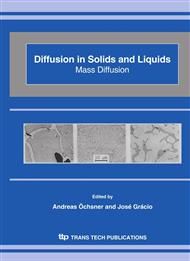p.270
p.276
p.282
p.288
p.294
p.299
p.305
p.310
p.316
Reactive Diffusion in Cu-Nb-Sn Internal Tin Superconducting Wires for the ITER Project
Abstract:
The reactive diffusion and phase formation sequences in two types of ‘internal tin’ superconducting wires designed for the ITER project, which investigates the production of electricity by means of nuclear fusion, have been studied during heat treatments both in situ, using electrical resistometry [1] and ex situ, using optical and scanning electron microscopy, energy dispersive X-ray spectrometry (EDS) and X-ray Micro-Tomography (XMT). XMT reveals long pores in the longitudinal direction which may result in tin deficiency thereat and hence local off-stoichiometric Nb3Sn. Microscopy suggests there are incomplete conversion of elemental tin to copper-tin intermetallics before ramping above the tin melting temperature, nonuniform distribution of tin before formation of Nb3Sn, and filament movement and bridging, stacking cracks and unreacted niobium at the end of the heat treatment. FEGSEM shows a fine microstructure which nevertheless could still be improved.
Info:
Periodical:
Pages:
294-298
Citation:
Online since:
October 2006
Keywords:
Price:
Сopyright:
© 2006 Trans Tech Publications Ltd. All Rights Reserved
Share:
Citation:


